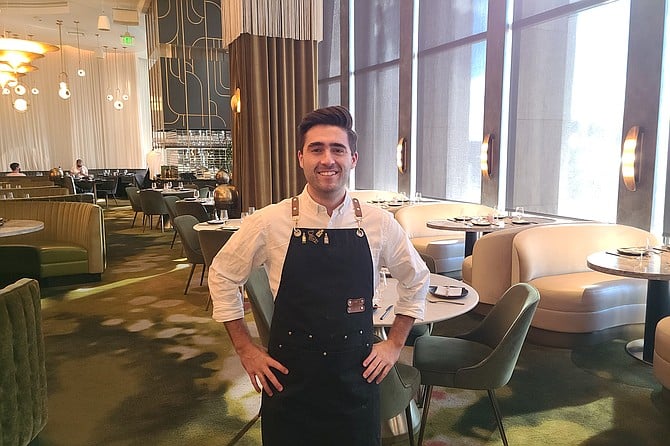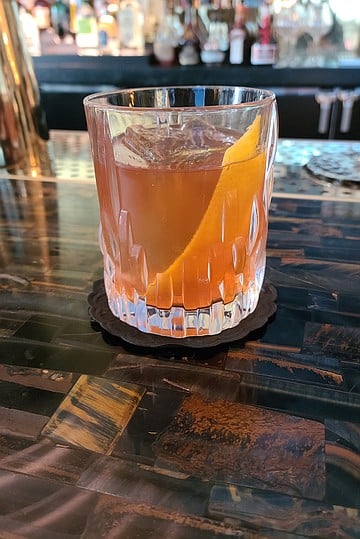 Facebook
Facebook
 X
X
 Instagram
Instagram
 TikTok
TikTok
 Youtube
Youtube

“Every single night, it’s probably the top seller,” says Anthony Belcufini about Animae’s A5 Old Fashioned. “And it ties into what we do in the back of the house with our steak program.” The cocktail’s name is a nod to the Japanese A5 Wagyu fat-washed bourbon made in-house, using cuts of meat ordered for the restaurant. “We get these long, long tenderloins and strip loins — and if you’re familiar with A5 Wagyu, the big thing is the fat content and marbleization. So there’s a tremendous amount of fat, that’s what makes it so good. But when we have to trim off all the excess fat, it costs us the same amount as the steak we’re serving ourselves.
In order to make the cost of the A5 more approachable to a lot of our diners, we use that fat throughout the menu, including the A5 Old Fashioned.” It seemed an obvious answer to him: “committing to using all of that beef that we’re importing, but also putting a much more elevated twist on something that’s been done.”
Each week, the chefs cut off the excess fat and render it down. “And then when I make my batch of bourbon, I basically get a big ol’ stock pot, put it on an induction burner and put one or two quarts of that fat in there,” he says, estimating his cooking temp at around 140-60 degrees. “Warm enough where that fat turns into an oil, but it’s a temperature low enough where the alcohol won’t evaporate.” After infusing the bourbon for several hours, the batch is stored in the freezer, “where the cold temperature is going to bring all that liquid fat back into a solid that rises all the way to the top.” The top layer of fat is then removed the next day, “and what you’re left with is a bourbon that’s richer, a little bit nutty, buttery, super smooth — I don’t like using the word ‘beefy,’ because I think that’s off-putting,” he clarifies, “but what you do get is the essence of the richness of that steak.”
To top it off, Belcufini adds a bit of Shio Koji. “It’s almost like a rice-based salt liquid... after it’s been softened, I find that it opens up your palate a lot more.” Angostura bitters and an orange twist complete the cocktail recipe. “You get a lot of the aromatics from that. You get the strength, the punch of a nice stiff Old Fashioned, you get a lot more savory quality to it.” The fat-washing technique also produces a different mouthfeel. “I hope it’s the smoothest Old Fashioned that anybody will ever have,” he says earnestly.
The base bourbon changes depending on what they have at their disposal. “Sometimes a little scotch might make it in, sometimes a bit of rye. It’s a very consistent drink,” he maintains, “but like a snowflake, each one is just a little unique.”



“Every single night, it’s probably the top seller,” says Anthony Belcufini about Animae’s A5 Old Fashioned. “And it ties into what we do in the back of the house with our steak program.” The cocktail’s name is a nod to the Japanese A5 Wagyu fat-washed bourbon made in-house, using cuts of meat ordered for the restaurant. “We get these long, long tenderloins and strip loins — and if you’re familiar with A5 Wagyu, the big thing is the fat content and marbleization. So there’s a tremendous amount of fat, that’s what makes it so good. But when we have to trim off all the excess fat, it costs us the same amount as the steak we’re serving ourselves.
In order to make the cost of the A5 more approachable to a lot of our diners, we use that fat throughout the menu, including the A5 Old Fashioned.” It seemed an obvious answer to him: “committing to using all of that beef that we’re importing, but also putting a much more elevated twist on something that’s been done.”
Each week, the chefs cut off the excess fat and render it down. “And then when I make my batch of bourbon, I basically get a big ol’ stock pot, put it on an induction burner and put one or two quarts of that fat in there,” he says, estimating his cooking temp at around 140-60 degrees. “Warm enough where that fat turns into an oil, but it’s a temperature low enough where the alcohol won’t evaporate.” After infusing the bourbon for several hours, the batch is stored in the freezer, “where the cold temperature is going to bring all that liquid fat back into a solid that rises all the way to the top.” The top layer of fat is then removed the next day, “and what you’re left with is a bourbon that’s richer, a little bit nutty, buttery, super smooth — I don’t like using the word ‘beefy,’ because I think that’s off-putting,” he clarifies, “but what you do get is the essence of the richness of that steak.”
To top it off, Belcufini adds a bit of Shio Koji. “It’s almost like a rice-based salt liquid... after it’s been softened, I find that it opens up your palate a lot more.” Angostura bitters and an orange twist complete the cocktail recipe. “You get a lot of the aromatics from that. You get the strength, the punch of a nice stiff Old Fashioned, you get a lot more savory quality to it.” The fat-washing technique also produces a different mouthfeel. “I hope it’s the smoothest Old Fashioned that anybody will ever have,” he says earnestly.
The base bourbon changes depending on what they have at their disposal. “Sometimes a little scotch might make it in, sometimes a bit of rye. It’s a very consistent drink,” he maintains, “but like a snowflake, each one is just a little unique.”
